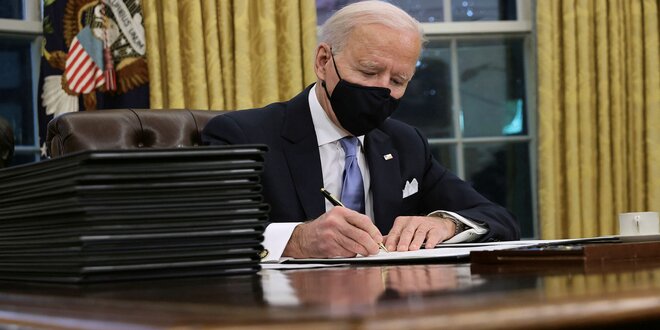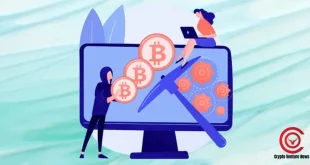The U.S President Joe Biden on 09.03.2022 signed an executive order calling on his government to evaluate the benefits and risks of using digital currency. To many, these orders were not clear and so today we will be having a clear look at the Biden executive order. So here are some Biden executive orders news.
This order is a long awaited directive that has had the crypto space on edge, not because of the growing regulatory issues across the globe covering the novice digital currency space. There had been reports that talk about a divide between White House officials and Treasury Secretary Janet Yellen leading to lags in policy rollout.
The crypto space got winded up with the Biden executive order crypto overnight after the Treasury unintentionally put forward a since deleted statement terming it “historic” and launching some of the details before time.
Those Biden executive orders were finally signed on 09.03.2022 (Wednesday). It asked the federal agencies to take unified strategies to regulate and oversee digital assets as per the fact sheets that were offered by the White House.
What Exactly The Biden Executive Order Spoke About?
The U.S President Joe Biden has laid forward several categories based on which the federal officials would have to examine crypto. Under that Biden executive order, he also instructed the Treasury Department to evaluate the impact of digital currency on national security and financial stability. For a clear understanding let us have a look at all the criteria that are considered in the US when it is to cryptocurrency. Here is the list of 5 executive orders signed that day.
1. Protecting Consumers
The measures declared Wednesday will aim at six primary areas:
- Protection of consumer and investor
- Financial stability
- Illicit activity
- U.S. competitiveness on a global platform
- Financial inclusion
- Responsible innovation
Safeguarding consumers is a crucial part of the directive. There have been numerous stories of investors falling prey to crypto scams, or losing huge amounts of money via cyberattacks on exchanges or users themselves.
The administration of Biden is calling on the Treasury to develop and assess policy suggestions on crypto. It also wishes regulators to
“ensure sufficient oversight and safeguard against any systemic financial risks posed by digital assets.”
While policymakers have been interested to downplay any systemic risks that result from crypto, there have been rising issues over the role played by stablecoins. These are virtual tokens that are created to be pegged to the value of prevailing currencies such as the U.S. dollar.
Tether, the largest stablecoin across the globe with $80 billion in circulation, has brought in the ire of regulators over claims its token is not effectively backed by dollars held in reserve. Tether states its coin is completely backed, however, the makeup of its reserves involves short-term debt obligations such as commercial paper, not just cash.
The idea of stablecoins was notably absent from the announcement at the White House on Wednesday, though Yellen has made it evident that she wishes to see Congress introduce regulation for the industry.
2. Illicit activity
Another prime area the Biden executive order focuses on is rooting out illegal actions in the crypto space. The president has called for an “unprecedented focus of coordinated action” from federal agencies in eliminating national security risks and illicit finance posed by digital currencies. He is also asking for international collaboration on the issue.
Last month, U.S. officials seized $3.6 billion worth of BTC and that was their biggest seizure of digital currencies ever. It was related to the 2016 hack of crypto exchange Bitfinex. Following the invasion of Russia in Ukraine, authorities are now also worried about the possible usage of crypto in helping sanctioned Russian people and entities evade the restrictions.
Proponents of crypto state it is highly hard for funds to be laundered via digital currency, however, as all transactions are kept public on an irreversible record-keeping system called the blockchain.
3. Climate Change
It is a more subtle point, but Biden also mentioned the sheer energy cost baked into digital currencies such as Bitcoin. The Biden executive order wants the government to evaluate ways to make crypto innovation more “responsible,” decreasing any negative climate impacts.
Bitcoin depends on a mechanism known as PoW (Proof of Work) to assure transactions and develop new units of currency. A decentralized network of computers fights to solve complicated math puzzles in order to mine the crypto. The more computing power a miner holds, the higher their chances of being rewarded in the new BTC.
That has raised alarm for policymakers across the globe, with China even banning crypto mining fully last year. That shift led to an exodus of crypto miners from the nation to the U.S. and other nations, like Kazakhstan.
4. U.S. competitiveness
Part of the language in the White House declaration aims at offering the U.S. a competitive edge over other nations when it comes to crypto enhancement. This is especially prominent presently that China has effectively banned digital currencies.
Biden has assigned the Department of Commerce with the job of
“establishing a framework to drive U.S. competitiveness and leadership in, and leveraging of digital asset technologies.”
Several crypto industry figures have raised their voice for such action, including the bosses of Kraken, Coinbase, and the Winklevoss twins’ Gemini exchange.
The Blockchain Association, which is an organization that portrays several well-known crypto entities, said on 09.03.2022 that,
“Biden has the opportunity to ensure America remains the global leader for technological innovation for years to come.”
5. Digital dollar
This is the final one on the Biden executive orders list. The Biden administration also wishes to explore a digital variant of the dollar. It arrives as China has led the charge toward CBDC (central bank digital currencies), with more and more people availing smartphones to make payments and handle their finances.
Biden is not saying whether the U.S. should release its own virtual currency. Rather, he is calling on the government to place “urgency” on the R&D of a potential CBDC.
The Federal Reserve last year started to work on exploring the potential issuance of a digital dollar. The central bank launched a long-awaited report that spoke about the pros and cons of such digital money but did not take a position yet on whether it thinks the U.S. should issue one.
While CBDCs could instantly speed up the settlement of payments, policymakers are understanding a number of issues around privacy and financial stability.
Conclusion
President Biden executive order helps kick off the serious analysis of the U.S. government on crypto, which is an assessment that should finally lead to regulations and laws that establish a set of ground rules for the sector. Those rules should help formulate trust and acceptance in these spaces, helping them to further develop.







